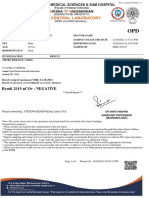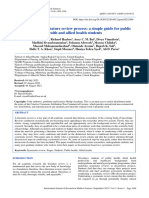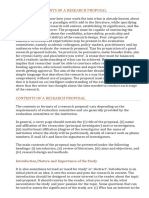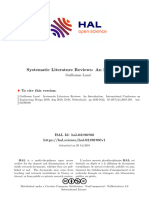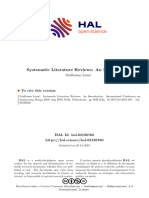(Strobe) Guideline
Uploaded by
Joseph Bennett(Strobe) Guideline
Uploaded by
Joseph BennettReview Article
The STROBE guidelines
ABSTRACT
An observational study is a type of epidemiological study design, which can take the form of a cohort, a case–control,
or a cross‑sectional study. When presenting observational studies in manuscripts, an author needs to ascertain a clear
presentation of the work and provide the reader with appropriate information to enable critical appraisal of the research. The
Strengthening the Reporting of Observational studies in Epidemiology (STROBE) guidelines were created to aid the author
in ensuring high‑quality presentation of the conducted observational study. The original articles publishing the STROBE
guidelines together with their bibliographies were identified and thoroughly reviewed. These guidelines consist of 22 checklist
items that the author needs to fulfil before submitting the manuscript to a journal. The STROBE guidelines were created
to aid the authors in presenting their work and not to act as a validation tool for the conducted study or as a framework to
conduct an observational study on. The authors complying with these guidelines are more likely to succeed in publishing
their observational study work in a journal.
Key words: Data reporting; epidemiology; observational studies; publishing; research design
Introduction to aid in the presentation of the conducted observational
study to ensure adequate reporting (what was planned, done,
Different epidemiological study designs are available and found, and concluded) as well as assessment of the strengths
are adopted by a researcher depending on the research and weaknesses of the study.[1,2] Such study information is
question at hand. An observational study is one type of of vital importance in a manuscript since this will determine
epidemiological study design, which can be in the form of a whether the established results can be included in systemic
cohort, a case–control, or a cross‑sectional study. This type of reviews later on.[3,4] Furthermore, the STROBE guidelines
study design (observational) is defined as a nonexperimental enable the journal’s editor, reviewers, and the readers to
research, where the researcher observes a particular critically appraise the study.[1]
environmental behavior without artificially controlling the
environment under study. To ascertain high‑quality reporting The STROBE Guidelines
of observational studies, the Strengthening the Reporting of
Observational studies in Epidemiology (STROBE) guidelines The aim of the STROBE guidelines was to provide a readily
were developed following a collaborative initiative of available checklist to ensure a clear presentation of what
epidemiologists, methodologists, statisticians, researchers, was planned and conducted in an observational study.
and journal editors in 2004.[1] These guidelines were created These studies are set out to investigate the associations
Access this article online This is an open access journal, and articles are distributed under
Quick Response Code
the terms of the Creative Commons Attribution-NonCommercial-
Website: ShareAlike 4.0 License, which allows others to remix, tweak, and
www.saudija.org build upon the work non-commercially, as long as appropriate credit
is given and the new creations are licensed under the identical terms.
For reprints contact: reprints@medknow.com
DOI:
10.4103/sja.SJA_543_18 How to cite this article: Cuschieri S. The STROBE guidelines. Saudi
J Anaesth 2019;13:S31-4.
Sarah Cuschieri
Department of Anatomy, Faculty of Medicine and Surgery, Biomedical Building, University of Malta, Msida, Malta
Address for correspondence: Dr. Sarah Cuschieri, Department of Anatomy, Faculty of Medicine and Surgery, Biomedical Building,
University of Malta, Msida MSD 2080, Malta. E‑mail: sarah.cuschieri@um.edu.mt
© 2019 Saudi Journal of Anesthesia | Published by Wolters Kluwer - Medknow S31
Cuschieri: STROBE - Guidelines for publishing observational studies
between an exposure and a health outcome. In no way were guidelines do not allow the use of the words “prospective”
these guidelines established to provide a methodological or “retrospective” or “concurrent” or “historical,” but
framework for conducting an observational study.[1] Nor rather encourage the researcher to describe the actual
were the guidelines developed as an instrument for quality methodology.[1]
evaluation of observational research.[2] Furthermore, the
guidelines were not aimed to bring forward standardization Information on the tools of measurement, setting, and
of manuscripts but rather to encourage the production locations should be reported to enhance the reader’s
of interesting and narrative articles while maintaining understanding of the study’s results. The reporting of the
transparency.[5] participants’ recruitment procedure will vary depending on
the type of observation design being conducted. Therefore,
The Strobe Checklist it is important that the researcher is knowledgeable about
the epidemiological methodological design for each
A total of 22 checklist items contribute to the STROBE different observational study (i.e., cohort, case–control, or
guidelines. Eighteen items are common to all the three cross‑sectional, respectively).
observational designs, that is, cohort, cross‑sectional, and
case–control studies. However, the remaining four checklist All the variables considered for the descriptive and
items (items number 6, 12, 14, and 15) have specific statistical analysis of the study need to be noted down
variations according to the study design. Table 1 exhibits within the methods section. This also includes the
the STROBE guidelines as published by Vandenbroucke reporting of any specific cut‑off points implemented
et al.[1] The following is an abbreviated explanation of the during the analysis. It is essential that any exposures,
checklist items. confounders, or outcomes measurements are accounted
for and reported for the reader to critically appraise the
Item 1: Title and Abstract study’s reliability and validity. The inclusion and exclusion
criteria and methods to overcome any potential bias should
The adopted study design should be part of the manuscript be noted down as well.
title to ensure correct indexing of the manuscript in
electronic databases. Indexing of the published manuscript The method used to establish the study size needs to be
is of utmost importance to ensure visibility of a researcher’s reported along with the confidence intervals considered.
work and increase the citation potential of the published This is essential for the reader to ascertain whether sufficient
manuscript. Citation of published manuscripts is imperative statistical precision has been attained in the study.[1]
for the enhancement of the researcher’s research metrics
and for increasing the prestigious acknowledgement of The reporting of statistical analysis will vary depending on the
the researcher and his or her work within the scientific study design (i.e., cohort, case–control, or cross‑sectional).
community.[6] The abstract should include a brief summary However, it is important that all statistical methods and
of the study and present only information found within the adjustments for potential confounders or missing data are
actual body of the manuscript. noted down clearly.
Items 2 and 3: Introduction Items 13–17: Results
The introduction should consist of background information The results section should give an in‑depth account of the
that will set the scene for the study and the objective of the response rate and the description of the study population
study. The objective states the researcher’s intentions for along with the main descriptive and analytical results. The
conducting the study and potential hypotheses that may information provided will depend on the type of observational
arise from such work. design (i.e., cohort, case–control, or cross‑sectional) followed
by the researcher and the corresponding statistical analysis
Items 4–12: Methods performed.
The methods section should provide a clear description Items 18–21: Discussion
of the study design at an early stage. This will enable the
reader to understand the basis of the study and be able to The discussion should address all the central issues of the
critically appraise the study’s methodology. The STROBE study including the validity of the study. The objective/s of the
S32 Saudi Journal of Anesthesia / Volume 13 / Supplement 1 / April 2019
Cuschieri: STROBE - Guidelines for publishing observational studies
Table 1: STROBE guidelines
STROBE guidelines
Section/topic Item number Recommendation
Title and abstract 1 Indicate the study’s design with a commonly used term in the title or the abstract
Provide in the abstract an informative and balanced summary of what was done and what was found
Introduction
Background/rationale 2 Explain the scientific background and rationale for the investigation being reported
Objectives 3 State specific objectives, including any prespecified hypotheses
Methods
Study design 4 Present key elements of study design early in the manuscript
Setting 5 Describe the setting, locations, and relevant dates, including periods of recruitment, exposure, follow‑up,
and data collection
Participants 6 Cohort study – give the eligibility criteria, and the sources and methods of selection of participants;
describe methods of follow‑up
Case–control study – give the eligibility criteria, and the sources and methods of case ascertainment and
control selection; give the rationale for the choice of cases and controls
Cross‑sectional study – give the eligibility criteria, and the sources and methods of selection of
participants
Cohort study – for matched studies, give matching criteria and number of exposed and unexposed
Case–control study – for matched studies, give matching criteria and the number of controls per case
Variables 7 Clearly define all outcomes, exposures, predictors, potential confounders, and effect modifiers; give
diagnostic criteria, if applicable
Data sources/measurement 8* For each variable of interest, give sources of data and details of methods of assessment (measurement);
describe comparability of assessment methods if there is more than one group
Bias 9 Describe any efforts to address potential sources of bias
Study size 10 Explain how the study size was arrived at
Quantitative variables 11 Explain how quantitative variables were handled in the analyses; if applicable, describe which groupings
were chosen and why
Statistical methods 12 Describe all statistical methods, including those used to control for confounding
Describe any methods used to examine subgroups and interactions
Explain how missing data were addressed
Cohort study – if applicable, explain how loss to follow‑up was addressed
Case–control study – if applicable, explain how matching of cases and controls was addressed
Cross‑sectional study – if applicable, describe analytical methods taking account of sampling strategy
Describe any sensitivity analyses
Results
Participants 13* Report numbers of individuals at each stage of study – e.g., numbers potentially eligible, examined for
eligibility, confirmed eligible, included in the study, completing follow‑up, and analyzed
Give reasons for nonparticipation at each stage
Consider use of a flow diagram
Descriptive data 14* Give characteristics of study participants (e.g., demographic, clinical, social) and information on
exposures and potential confounders
Indicate number of participants with missing data for each variable of interest
Cohort study – summarize follow‑up time (e.g., average and total amount)
Outcome data 15* Cohort study – report numbers of outcome events or summary measures over time
Case–control study – report numbers in each exposure category, or summary measures of exposure
Cross‑sectional study – report numbers of outcome events or summary measures
Main results 16 Give unadjusted estimates and, if applicable, confounder‑adjusted estimates and their precision (e.g.,
95% confidence interval); make clear which confounders were adjusted for and why they were included
Report category boundaries when continuous variables were categorized
If relevant, consider translating estimates of relative risk into absolute risk for a meaningful time period
Other analyses 17 Report other analyses done – e.g., analyses of subgroups and interactions, and sensitivity analyses
Discussion
Key results 18 Summarize key results with reference to study objectives
Limitations 19 Discuss limitations of the study, taking into account sources of potential bias or imprecision; discuss both
direction and magnitude of any potential bias
Interpretation 20 Give a cautious overall interpretation of results considering objectives, limitations, multiplicity of
analyses, results from similar studies, and other relevant evidence
Generalizability 21 Discuss the generalizability (external validity) of the study results
Contd...
Saudi Journal of Anesthesia / Volume 13 / Supplement 1 / April 2019 S33
Cuschieri: STROBE - Guidelines for publishing observational studies
Table 1: Contd...
STROBE guidelines
Section/topic Item number Recommendation
Other information
Funding 22 Give the source of funding and the role of the funders for the present study and, if applicable, for
the original study on which the present article is based
*Give information separately for cases and controls in case–control studies and, if applicable, for exposed and unexposed groups in cohort and cross‑sectional studies
study should be kept in mind while discussing the findings. observational‑study‑inspired manuscript. Having a thorough
Comparisons to already published literature are essential. It understanding of the STROBE guidelines is therefore
may be appropriate for the discussion section to be subdivided becoming a requisite for authors who wish to conduct and
into different sections to enable better interpretation of the publish an observational study. These guidelines have been
study findings. The researcher should provide an objective formulated as an aid to authors to enable them to construct
assessment of the findings and avoid overinterpretations. an adequately presented manuscript that allows the reader
Potential confounder effects that might have had an effect on to fully comprehend and critically appraise the manuscript.
the results and associations obtained in the study should be
considered. Therefore, it is imperative to note down potential Financial support and sponsorship
limitations faced by the study, while noting any bias that might Nil.
have been present. Furthermore, researchers have to keep in
mind that causality of a particular outcome cannot be established Conflicts of interest
in most study designs, unless a longitudinal cohort study has There are no conflicts of interest.
been conducted. Therefore, this fact needs to be acknowledged
during the discussion and may act as a study limitation for
References
certain study designs. Study limitations go hand in hand with
recommendations for further research to validate the study or 1. Vandenbroucke JP, von Elm E, Altman DG, Gøtzsche PC, Mulrow CD,
further establish associations that were revealed by the study. Pocock SJ, et al. Strengthening the reporting of observational studies
in epidemiology (STROBE): Explanation and elaboration. PLoS Med
Item 22: Funding and Sponsorship 2007;4:e297.
2. von Elm E, Altman DG, Egger M, Pocock SJ, Gøtzsche PC,
Vandenbroucke JP, et al. Strengthening the reporting of observational
The source of funding and the role of the funders in the study studies in epidemiology (STROBE) statement: Guidelines for reporting
are essential pieces of information that are required at the observational studies. BMJ 2007;335:806‑8.
end of the article. This is accompanied with any conflict of 3. Jüni P, Altman DG, Egger M. Systematic reviews in health care:
interest of both the author/s and the funders. Assessing the quality of controlled clinical trials. BMJ 2001;323:42‑6.
4. Egger M, Schneider M, Davey Smith G. Spurious precision?
Meta‑analysis of observational studies. BMJ 1998;316:140‑4.
Conclusion
5. Schriger DL. Suggestions for improving the reporting of clinical
research: The role of narrative. Ann Emerg Med 2005;45:437‑43.
A substantial number of journals are requesting authors 6. Cuschieri S. WASP (Write a scientific paper): Understanding research
to follow the STROBE guidelines before submitting their metrics. Early Hum Dev 2018;118:67‑71.
S34 Saudi Journal of Anesthesia / Volume 13 / Supplement 1 / April 2019
You might also like
- Training Record For Work Placement Handbook: CHC43015 Certificate IV in Ageing SupportNo ratings yetTraining Record For Work Placement Handbook: CHC43015 Certificate IV in Ageing Support206 pages
- Patient Name Doctor Name Pat Reg Id Sample Collected Date SEX Reporting Date AGE Sample Id ReportstatusNo ratings yetPatient Name Doctor Name Pat Reg Id Sample Collected Date SEX Reporting Date AGE Sample Id Reportstatus2 pages
- 1) Guidelines For Preparing The Thesis & Research Project - MbaNo ratings yet1) Guidelines For Preparing The Thesis & Research Project - Mba26 pages
- Navigating the Qualitative Manuscript ProcessNo ratings yetNavigating the Qualitative Manuscript Process4 pages
- Global Emergency Medicine Literature Review100% (2)Global Emergency Medicine Literature Review4 pages
- Systematic Quantitative Literature Review MethodNo ratings yetSystematic Quantitative Literature Review Method7 pages
- Definition of A Research Project and Specifications For Fulfilling The RequirementNo ratings yetDefinition of A Research Project and Specifications For Fulfilling The Requirement6 pages
- The Systematic Literature Review Process: A Simple Guide For Public Health and Allied Health StudentsNo ratings yetThe Systematic Literature Review Process: A Simple Guide For Public Health and Allied Health Students9 pages
- Writing An Effective Literature Review: Amanda Bolderston, M.R.T. (T), BSC, MSC, FcamrtNo ratings yetWriting An Effective Literature Review: Amanda Bolderston, M.R.T. (T), BSC, MSC, Fcamrt7 pages
- By Dr. Sohail Saadat Assistant Professor Dikiohs-DuhsNo ratings yetBy Dr. Sohail Saadat Assistant Professor Dikiohs-Duhs34 pages
- Basic Requirements of A Research ProposalNo ratings yetBasic Requirements of A Research Proposal4 pages
- Characteristics of Systematic Literature Review100% (2)Characteristics of Systematic Literature Review10 pages
- Shakarchi - 2022 (How To Write A Research Study Protocol)No ratings yetShakarchi - 2022 (How To Write A Research Study Protocol)2 pages
- Consolidated Criteria For Reporting Qualitative Research (COREQ) : A 32-Item Checklist For Interviews and Focus GroupsNo ratings yetConsolidated Criteria For Reporting Qualitative Research (COREQ) : A 32-Item Checklist For Interviews and Focus Groups10 pages
- How To Get Started With A Systematic Review in EpidemiologyNo ratings yetHow To Get Started With A Systematic Review in Epidemiology8 pages
- Maintaining Quality and Accuracy in Ophthalmology Academic Research The Importance of Traditional Peer ReviewNo ratings yetMaintaining Quality and Accuracy in Ophthalmology Academic Research The Importance of Traditional Peer Review3 pages
- Guidelines For Writing A Systematic ReviewNo ratings yetGuidelines For Writing A Systematic Review7 pages
- How To Write A Systematic Literature Review in Nursing100% (1)How To Write A Systematic Literature Review in Nursing8 pages
- Systematic Literature Reviews An IntroductionNo ratings yetSystematic Literature Reviews An Introduction11 pages
- Research proposal guidelines_Final 3 pagesNo ratings yetResearch proposal guidelines_Final 3 pages3 pages
- Systematic Literature Reviews An IntroductionNo ratings yetSystematic Literature Reviews An Introduction11 pages
- PRESENTATION-OF-WRITTEN-RESEARCH-METHODOLOGY_corrected-copyNo ratings yetPRESENTATION-OF-WRITTEN-RESEARCH-METHODOLOGY_corrected-copy16 pages
- Systematic Literature Reviews An IntroductionNo ratings yetSystematic Literature Reviews An Introduction10 pages
- How Long Does A Systematic Literature Review Take100% (1)How Long Does A Systematic Literature Review Take8 pages
- CONSORT For Reporting Randomized Controlled Trials in Journal and Conference Abstracts: Explanation and ElaborationNo ratings yetCONSORT For Reporting Randomized Controlled Trials in Journal and Conference Abstracts: Explanation and Elaboration9 pages
- Literature Review Simplified: The Checklist Edition: A Checklist Guide to Literature ReviewFrom EverandLiterature Review Simplified: The Checklist Edition: A Checklist Guide to Literature ReviewNo ratings yet
- Evaluasi Pelaksanaan Program Penanggulangan Tuberkulosis Paru (P2Tb) Di Puskesmas Bandarharjo Kota SemarangNo ratings yetEvaluasi Pelaksanaan Program Penanggulangan Tuberkulosis Paru (P2Tb) Di Puskesmas Bandarharjo Kota Semarang12 pages
- 176S Tuesday Posters Obstetrics & GynecologyNo ratings yet176S Tuesday Posters Obstetrics & Gynecology1 page
- Na Na Na Nothin' On You, Baby Na Nothin' On YouNo ratings yetNa Na Na Nothin' On You, Baby Na Nothin' On You1 page
- inbody720_cdmanual_eng_h-pdf-0059383001546245174No ratings yetinbody720_cdmanual_eng_h-pdf-005938300154624517477 pages
- Wilson-P.-Textbook-of-Psychotherapy-in-Psychiatric-Practise.-Ch.-19-Psychotherapy-with-Adolesence.No ratings yetWilson-P.-Textbook-of-Psychotherapy-in-Psychiatric-Practise.-Ch.-19-Psychotherapy-with-Adolesence.13 pages
- Hindusthan College of Arts and Science, Coimbatore in Partial Fulfilment of The Requirements For The Award of The Degree ofNo ratings yetHindusthan College of Arts and Science, Coimbatore in Partial Fulfilment of The Requirements For The Award of The Degree of36 pages
- Allied Silvassa Ansamiti, Silvassa - TheapplicationshouldreachtheundersignedonorNo ratings yetAllied Silvassa Ansamiti, Silvassa - Theapplicationshouldreachtheundersignedonor9 pages
- Matrix of Curriculum Standards (Competencies), With Corresponding Recommended Flexible Learning Delivery Mode and Materials Per Grading Period92% (13)Matrix of Curriculum Standards (Competencies), With Corresponding Recommended Flexible Learning Delivery Mode and Materials Per Grading Period4 pages
- User'S Guide: Hematology Calibrator Mek-CalNo ratings yetUser'S Guide: Hematology Calibrator Mek-Cal1 page
- Get Violence Against Women and the Law 1st Edition David L Richards free all chaptersNo ratings yetGet Violence Against Women and the Law 1st Edition David L Richards free all chapters83 pages
- Community Based Management of Acute Malnutrition100% (2)Community Based Management of Acute Malnutrition149 pages
- Ar 190-56 Army Civilian Police & Security ProgramNo ratings yetAr 190-56 Army Civilian Police & Security Program20 pages
- Homework Is Not A Waste of Time Debate Points100% (1)Homework Is Not A Waste of Time Debate Points8 pages
- Training Record For Work Placement Handbook: CHC43015 Certificate IV in Ageing SupportTraining Record For Work Placement Handbook: CHC43015 Certificate IV in Ageing Support
- Patient Name Doctor Name Pat Reg Id Sample Collected Date SEX Reporting Date AGE Sample Id ReportstatusPatient Name Doctor Name Pat Reg Id Sample Collected Date SEX Reporting Date AGE Sample Id Reportstatus
- 1) Guidelines For Preparing The Thesis & Research Project - Mba1) Guidelines For Preparing The Thesis & Research Project - Mba
- Definition of A Research Project and Specifications For Fulfilling The RequirementDefinition of A Research Project and Specifications For Fulfilling The Requirement
- The Systematic Literature Review Process: A Simple Guide For Public Health and Allied Health StudentsThe Systematic Literature Review Process: A Simple Guide For Public Health and Allied Health Students
- Writing An Effective Literature Review: Amanda Bolderston, M.R.T. (T), BSC, MSC, FcamrtWriting An Effective Literature Review: Amanda Bolderston, M.R.T. (T), BSC, MSC, Fcamrt
- By Dr. Sohail Saadat Assistant Professor Dikiohs-DuhsBy Dr. Sohail Saadat Assistant Professor Dikiohs-Duhs
- Shakarchi - 2022 (How To Write A Research Study Protocol)Shakarchi - 2022 (How To Write A Research Study Protocol)
- Consolidated Criteria For Reporting Qualitative Research (COREQ) : A 32-Item Checklist For Interviews and Focus GroupsConsolidated Criteria For Reporting Qualitative Research (COREQ) : A 32-Item Checklist For Interviews and Focus Groups
- How To Get Started With A Systematic Review in EpidemiologyHow To Get Started With A Systematic Review in Epidemiology
- Maintaining Quality and Accuracy in Ophthalmology Academic Research The Importance of Traditional Peer ReviewMaintaining Quality and Accuracy in Ophthalmology Academic Research The Importance of Traditional Peer Review
- How To Write A Systematic Literature Review in NursingHow To Write A Systematic Literature Review in Nursing
- PRESENTATION-OF-WRITTEN-RESEARCH-METHODOLOGY_corrected-copyPRESENTATION-OF-WRITTEN-RESEARCH-METHODOLOGY_corrected-copy
- CONSORT For Reporting Randomized Controlled Trials in Journal and Conference Abstracts: Explanation and ElaborationCONSORT For Reporting Randomized Controlled Trials in Journal and Conference Abstracts: Explanation and Elaboration
- Literature Review Simplified: The Checklist Edition: A Checklist Guide to Literature ReviewFrom EverandLiterature Review Simplified: The Checklist Edition: A Checklist Guide to Literature Review
- Evaluasi Pelaksanaan Program Penanggulangan Tuberkulosis Paru (P2Tb) Di Puskesmas Bandarharjo Kota SemarangEvaluasi Pelaksanaan Program Penanggulangan Tuberkulosis Paru (P2Tb) Di Puskesmas Bandarharjo Kota Semarang
- Wilson-P.-Textbook-of-Psychotherapy-in-Psychiatric-Practise.-Ch.-19-Psychotherapy-with-Adolesence.Wilson-P.-Textbook-of-Psychotherapy-in-Psychiatric-Practise.-Ch.-19-Psychotherapy-with-Adolesence.
- Hindusthan College of Arts and Science, Coimbatore in Partial Fulfilment of The Requirements For The Award of The Degree ofHindusthan College of Arts and Science, Coimbatore in Partial Fulfilment of The Requirements For The Award of The Degree of
- Allied Silvassa Ansamiti, Silvassa - TheapplicationshouldreachtheundersignedonorAllied Silvassa Ansamiti, Silvassa - Theapplicationshouldreachtheundersignedonor
- Matrix of Curriculum Standards (Competencies), With Corresponding Recommended Flexible Learning Delivery Mode and Materials Per Grading PeriodMatrix of Curriculum Standards (Competencies), With Corresponding Recommended Flexible Learning Delivery Mode and Materials Per Grading Period
- Get Violence Against Women and the Law 1st Edition David L Richards free all chaptersGet Violence Against Women and the Law 1st Edition David L Richards free all chapters


